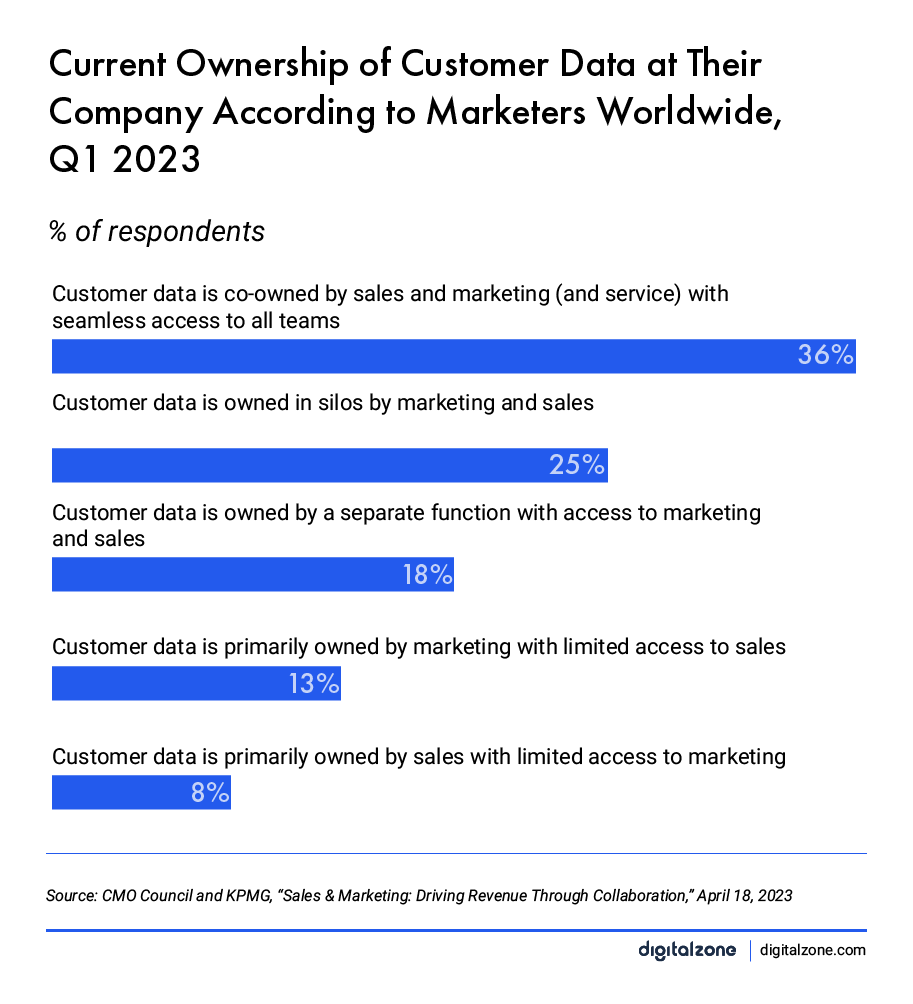
Breaking down silos for better demand gen experiences.
Published on 31 May, 2023 | Author: Digitalzone
We’ve all experienced it – the disjointedness of working in silos. Turns out, you’re not alone. 83% of companies report silos within their organization. And 97% agree that these silos can put a real damper on company performance. Time for a change, don’t you think?
In a recent survey by CMO Council and KPMG, respondents were asked, “which best describes current ownership of customer data in your org?” The outcome was kind of surprising, with only 36% of marketing and sales teams working together with their respective data to create a more cohesive approach.

While you’ve likely felt the impact of departments acting in silos across an organization, we’ve often seen silos crop up within a single department – like Marketing. With 65% of B2B buyers being Millennials, the bar for digital brand experiences has been raised and silos just aren’t going to cut it.
The impact of silos in demand generation
In demand gen, silos can really hinder campaign performance. Insights necessary to make the best decisions for your campaign usually live across teams, and when those insights aren’t shared and utilized in campaign development, you’re not putting your best foot forward.
Each team needs insights from the other to create a cohesive and impactful campaign. The Brand Team offers market trends and research, the Product/Content Team tailors content to your audience’s needs, and the Demand Gen Team ensures content hits the mark with precision.

Now, we know that even in siloed marketing teams your demand gen vendor is likely still able to deliver on that MQL goal of yours, but at Digitalzone we’ve found that long-term success rarely comes from merely ‘filling the pipeline with X number of MQLs’ but rather a holistic, beyond ordinary approach. So, you may have your MQL goals met, but without a more strategic approach, you can end up with a disjointed brand experience or MQLs that never convert.
Solutioning silos in demand generation
Every organization is different, and solutioning silos will never be a one-size fits all situation, but we’ve found that these 3 foundational elements can be the difference between success and failure.
Collaborate from the start.
There is always so much to do across a marketing organization, it can be easy to allow dedicated time for collaboration fall by the wayside. We’ve found that cross-team kick-off calls are a great way to get marketing stakeholders across brand, product, and demand gen briefed on the campaign and allow for clarifying Q&A, meaningful discussion, and collaboration.
Put your audience at the center.
When you pull together stakeholders from across the Marketing department you can get a clearer picture of who your ICP is, what is most relevant to them right now, and what solutions your brand brings to the table. These shared insights should be formally documented during times of collaboration and used as a North Star throughout the life of the campaign.
Everyone has to buy-in to make change real.
Breaking down silos isn’t top-down, or bottom-up – it requires buy-in from everyone. However, it’s usually an initiative that starts with leadership, maintained and optimized by the larger team. Often, the easiest way to get started is creating a process that everyone can get behind (we recommend collaborating across teams to build this out), clearly communicating that process across the department, and ensuring adoption through accountability and transparency.
Conclusion
Solutioning silos is no joke. It requires buy-in from top to bottom. New habits must be established and practiced, and it’s rarely smooth sailing. But the benefits far outweigh the obstacles to getting there.
We’ll leave you with a couple of questions to reflect:
- Is your marketing team siloed in your approach to developing content for demand gen campaigns?
- Do we create space for teams across the department to share insights with one another?
Digitalzone believes in an end-to-end approach to demand generation. One that breaks down silos and utilizes insights from across the marketing department. It’s a journey, but your business depends on it.
